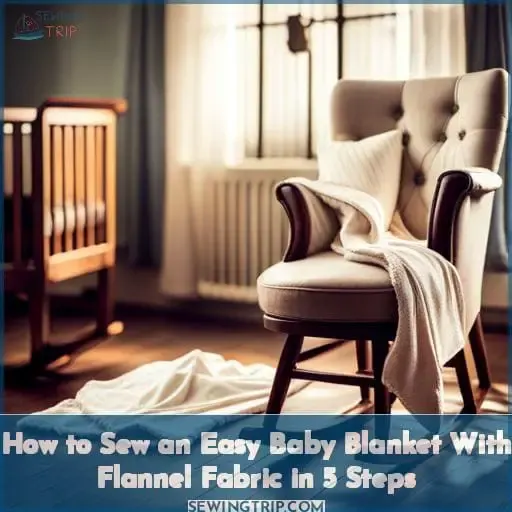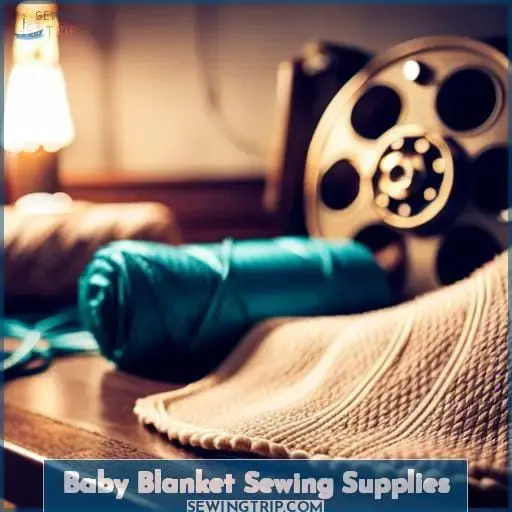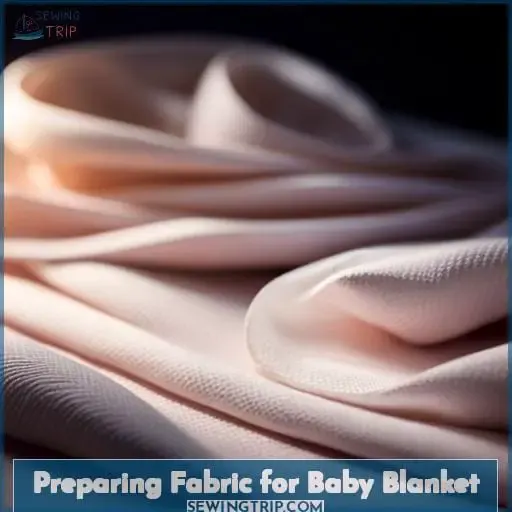This site is supported by our readers. We may earn a commission, at no cost to you, if you purchase through links.
 Soft, warm flannel beckons baby skin while harsh hospital linens repel.
Soft, warm flannel beckons baby skin while harsh hospital linens repel.
Trade sterile sheets for a handmade haven that envelops your little one in cozy comfort.
In five straightforward steps, I’ll teach you to sew a simple yet sublime blanket perfect for napping, nursing, or nuzzling.
With just flannel fabric, basic tools, and novice skills, you can create an heirloom treasure in less than an afternoon.
Let’s get started on a blanket that promises your child years of reliable snuggles!
Table Of Contents
Key Takeaways
- Choose soft, breathable fabrics like flannel or cotton and prewash prior to cutting
- Cut fabric pieces to identical sizes, pin together with right sides facing, and leave an opening for turning
- Sew around edges completely, clip corners, turn right side out through opening and press flat
- Add finishing touches like ties, ribbon, binding or trim for aesthetics and durability
Baby Blanket Sewing Supplies
You’ll need basic sewing supplies like fabric, thread, scissors, pins, and a sewing machine to make an easy baby blanket.
Choose soft, breathable fabrics like flannel or cotton. Flannel’s warmth and softness make it perfect for swaddling newborns.
Then, lay fabric right side up on a cutting mat, straighten edges, and cut uniform pieces using a rotary cutter.
Next, select coordinating thread colors and an appropriate needle for your fabric thickness. You’ll also need straight pins, fabric scissors, a seam ripper, and other basic sewing tools.
When ready to sew, pin fabric pieces together, right sides facing. Sew pieces using a 1/2 inch seam allowance, leaving an opening for turning right side out. Clip corners to reduce bulk. Topstitch finished edges for a polished look. Add ties, ribbon, or trim as desired.
Follow washing instructions on the fabric label to keep the blanket soft and durable with repeated use.
Preparing Fabric for Baby Blanket
First, prewash and dry your chosen flannel fabric before beginning your project.
Next, lay out the fabric pieces on a large flat surface. Use a rotary cutter and ruler to accurately measure and cut identical squares.
Finally, set aside any leftover scraps, as they may come in handy for making coordinating burp cloths or other accessories.
Wash and Dry Fabric
The fabric’s gotta be prewashed before you cut it so it doesn’t shrink unevenly after the blanket’s sewn.
- Wash in cold water and dry on low heat.
- Use a gentle detergent without dyes or fragrance.
- Don’t use fabric softener.
- Press with an iron on cotton setting when still slightly damp.
Following these simple wash tips when prepping the flannel or other fabric will help the handmade baby blanket hold its shape and last longer. Properly caring for the materials is an important first step in any baby blanket sewing project.
Lay Out and Cut Fabric
Having prewashed your fabric, lay it out flat on a cutting mat or clean floor. Cut your fabric pieces to the dimensions needed for your blanket.
When selecting fabric, 100% cotton flannel is ideal for its softness and durability. Measure the fabric width to calculate the yardage needed for your desired blanket size.
Use a rotary cutter and acrylic ruler to cut identical pieces, stacking them evenly before cutting.
If desired, incorporate creative variations like using contrasting prints or adding trim for a personalized baby blanket.
Sew an Easy Baby Blanket
Next, we’ll walk through sewing up your flannel baby blanket:
- Pin all fabric layers together.
- Sew around the edges completely, leaving an opening for turning right side out later.
- Once stitched, clip corners.
- Turn the blanket right side out through the opening.
- Press flat.
Pin Fabric Layers
With right sides facing in, pin your flannel layers together before sewing to keep them aligned as you stitch.
Evenly space straight pins around the blanket’s perimeter and through the middle to prevent shifting.
As a beginner, focus on keeping the fabric taut.
Mitered corners enable neat folding once the blanket is complete.
Consider personalizing this sewing project with appliqué accents using nursery fabric scraps.
Sew Around Edges
Once you’ve pinned the fabric layers, you’ll sew around the edges, leaving a 6-inch opening for turning the blanket right side out later.
Use a 1⁄2-inch seam allowance as you stitch around the blanket’s perimeter.
Remove the pins as you sew. Go slowly and keep the fabric layers aligned.
For durability, reinforce stitching at corners by backstitching several times.
Clip Corners and Turn Right Side Out
After you’ve sewn around the edges, clip the blanket’s corners and turn it right-side out through the opening.
Clip corners in triangular wedges, being careful not to cut the stitching. Use scissors at about a 45-degree angle.
Gently poke out the corners with a turning tool, if needed. Press with an iron so the blanket edges smoothly line up, then pin the opening closed, preparing to neatly finish your handmade baby blanket masterpiece.
How Much Fabric for Baby Blanket?
You’ll need enough fabric to construct the dimensions for the fabric cut outlined in your pattern or for the size you have in mind for the finished blanket.
- Soft pastels for a sweet baby boy or girl
- Vibrant primary colors for stimulation
- Soothing earth tones to promote security
- Playful prints to ignite wonder
Carefully measure and cut your fabric pieces according to the dimensions in your selected pattern.
Allow for shrinkage by prewashing fabric prior to cutting – flannel may shrink up to 20%!
You’ll find one yard of standard width flannel is typically sufficient for a receiving blanket or swaddle wrap.
Opt for wider cuts or more yardage if sewing a larger blanket.
Take time to thoughtfully select both pattern and hue to craft a meaningful, cherished baby blanket.
Best Fabric for Baby Blankets
When choosing fabrics for a baby blanket, opt for soft, gentle materials like flannel, jersey, or minky.
These fabrics withstand washing and wear while remaining smooth and cozy against a baby’s delicate skin.
Now, let’s discuss specifics on working with these fabrics to sew the perfect blanket.
Flannel
Frequently, you’re choosing flannel as the best fabric for baby blankets because of its softness against delicate newborn skin.
Opt for a tightly woven, 100% cotton flannel with a plush nap.
Prewash the fabric prior to cutting and sewing to prevent shrinkage.
When sewing flannel, use a size 70/10 or 80/12 sharps needle and polyester thread for best results.
Handle the fabric gently and use extra pins to avoid stretching.
Jersey
Consider using soft, stretchy jersey fabric for your baby blanket. It’s gentle against delicate skin.
Jersey’s natural stretch allows for easy sewing and wrapping baby snugly.
Look for solid colors or sweet prints in cotton jersey for the ultimate cozy blanket.
Stretchy jersey makes a thoughtful handmade baby gift, crafted with care for newborn comfort.
Jersey’s flexibility suits swaddling or stroller blankets equally well.
Minky
With minky as your fabric choice, you’re getting an ultra-soft and cuddly blanket perfect for babies.
For optimal softness, prewash minky prior to cutting and sewing.
When stitching, use a walking foot and lengthen the stitch length to allow the thick fabric to feed smoothly.
Minky’s plush texture adds cozy warmth, making it ideal for nursing covers, stroller blankets, and crib sheets.
Like flannel, minky blankets make thoughtful handmade gifts.
Popular Baby Blanket Sizes
When making a baby blanket, you’ll need to decide on the size.
Typical options are:
- 45 by 60 inches for crib blankets
- Around 40 inches square for swaddle blankets
The dimensions you choose depend on:
- The baby’s age
- How the blanket will be used
Crib Blanket Dimensions
You’ll want your handmade baby blanket to fit nicely in the crib, so typical crib blanket dimensions are around 45 by 60 inches.
This allows for a cozy blanket that’s just the right size to go over the mattress and railings, with a few extra inches for tucking in around the sides.
When planning your next flannel fabric blanket project, keep standard crib mattress sizes in mind – a 45 x 60 inch blanket will generally have enough coverage.
You can make the blanket slightly larger or smaller, depending on your preference for more drape over the edges or a trimmer overall fit.
The width should allow the flannel blanket to stretch all the way across the crib from side to side when the little one is tucked in for naptime.
A length of 60 inches gives you extra room for adjustments.
Receiving Blanket Dimensions
Since crib blankets are typically around 45 by 60 inches, you’re probably wondering what size receiving blankets usually are.
These handy blankets come in a variety of dimensions to suit different purposes, but common sizes are 36 by 36 inches and smaller.
Perfect for swaddling or burping a newborn, 30 by 30 inch receiving blankets are a popular choice.
For a multipurpose throw, try 32 by 40 inches.
When sewing your own, allow for a half-inch seam allowance.
Choose soft, gently nubby fabrics like flannel or textured cotton.
Once your receiving blanket is complete, simply toss it in the washing machine – no special care needed!
Add Finishing Touches
When your flannel baby blanket is complete, it’s time for those final embellishments.
Topstitch around the edges for a tidy look, or attach bias tape or ribbon trim for additional style.
A hand-sewn blanket label makes a personalized finishing touch.
Topstitch Edges
Further refining your handmade blanket, meticulous topstitching lends durability while accentuating the edges in an aesthetically pleasing way.
Use a longer stitch length and quality thread in a coordinating color for topstitching.
Take your time guiding the fabric edges under the presser foot to keep stitches straight and prevent puckering.
Try a wide zigzag stitch or other decorative stitches for additional flair.
Hand-wind bobbins with thicker threads like pearl cotton for a homespun look.
Whatever stitch you choose, maintain consistency for a cohesive finish.
Topstitching protects edges and provides a tailored finish to your baby blanket gift made with love.
Add Binding or Trim
You can add binding or trim to give your baby blanket a polished finish.
Using bias tape or ribbon, neatly fold the binding over the edges and stitch in place.
Add pretty lace trim using a zigzag stitch.
Sew on colorful pom pom fringe for a playful edge.
Attach satin ribbon using a straight stitch for smooth binding.
Finish with a wide border of contrasting fabric stitched on.
Wash and Care for Baby Blanket
After you’ve sewn your beautiful new flannel baby blanket, it’s time to get it ready for baby cuddles!
Make sure to wash the blanket before giving it to baby. Machine wash in cold water with a gentle detergent. Flannel may shrink slightly when washed, so check the measurements afterward. Never use bleach on baby items.
For best results, line dry or tumble dry on low. The flannel will stay soft with air drying.
When the blanket isn’t in use, store it folded in baby’s closet or drawer. Properly caring for the blanket will help it last through many snuggles and washes.
Your handmade blanket will become baby’s favorite as you dutifully wash and renew its softness.
Frequently Asked Questions (FAQs)
What size blanket should I make for a baby shower gift?
For a baby shower gift, make a 36 by 45 receiving blanket.
This versatile mid-size works for strollers, cribs, tummy time, and more.
Keep baby cozy with soft fabrics like flannel or cotton.
Gift your talents along with the warmth and comfort a handmade blanket provides.
Can I use a serger machine instead of a sewing machine?
Yes, you can use a serger instead of a sewing machine.
Be sure to use an appropriate overlock stitch and quality thread so the edges don’t fray over time with repeated washings.
This will create a tidy, professional finish.
How do I Sew mitered corners on a baby blanket?
When sewing mitered corners on a baby blanket:
Fold the corner diagonally like a wrapped gift before sewing, creating a crisp point as sharp as an elf’s hat.
Stitch along the fabric edge, pivoting at the corner bend.
Clip the excess seam allowance and press the seams open to reveal neat angles snug as a bug in a rug.
What kind of batting should I use for a baby blanket?
I would recommend a light loft polyester batting for baby blankets.
It’s soft, breathable, and easy to quilt through.
Just be sure to pre-wash any batting to prevent later shrinkage issues.
A mid-weight cotton batting is another good option that’s natural and gentle against baby’s skin.
Either will make a cozy blanket baby will love.
How can I add applique or embroidery designs to a baby blanket?
Simply stitching on appliques or embroidered designs before assembling the blanket adds a special touch.
Choose easy-care fabrics and gentle designs to delight baby while considering safety and softness first.
Conclusion
That’s a wrap, folks!
Crafting a cozy custom blanket for your bundle of joy needn’t break the bank or your back.
With a few yards of flannel, basic tools, and a bit of elbow grease, you can whip up a baby blanket in an afternoon.
Making it yourself with love adds an extra dose of comfort that store-bought can’t match.
Follow these simple steps to sew a sublime blanket that will snuggle your little peach for years to come.














